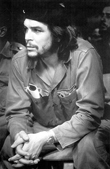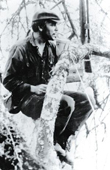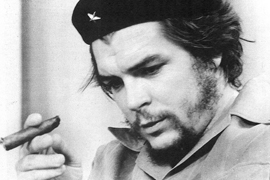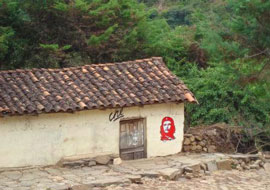|
Ernesto Guevara (1928-1967)
 The man known worldwide as Che Guevara, he was born in Rosario, Argentina on July 14, 1928. He studied medicine but never became a doctor. At 24 he traveled throughout South America and arrived in Bolivia the first time in 1953 during a full-fledged revolution. In 1955 he met Fidel Castro and his brother Raul in Mexico where they became friends. Later he joined their revolutionary group and landed in Cuba with them in 1956. He participated in the decisive battle of Santa Clara in 1958 and the later taking of Havana in 1959. The man known worldwide as Che Guevara, he was born in Rosario, Argentina on July 14, 1928. He studied medicine but never became a doctor. At 24 he traveled throughout South America and arrived in Bolivia the first time in 1953 during a full-fledged revolution. In 1955 he met Fidel Castro and his brother Raul in Mexico where they became friends. Later he joined their revolutionary group and landed in Cuba with them in 1956. He participated in the decisive battle of Santa Clara in 1958 and the later taking of Havana in 1959.
After the revolution he was given Cuban citizenship and was named head of the Militia and director of the Banco National Institute of Agrarian Reform (1959), Minister of the Economy (1960) and finally Minister of Industry (1961). In 1965 Che went to fight in the Belgian Congo and then disappeared for a while. He reappeared commanding a force in Bolivia where he fought from March to October 1967.
|
 October 9th commemorates another year since the death of the legendary Che Guevara, the guerilla leader who entered history as an icon of revolution.
October 9th commemorates another year since the death of the legendary Che Guevara, the guerilla leader who entered history as an icon of revolution.
Che fought his last battle in Bolivia. After having disappeared from public awareness for a period of time, Ernesto “Che” Guevara reappeared in Bolivia, crossing the border under a false identity on November 4, 1966.
Why did Che come to Bolivia?
He firmly believed that Bolivia’s geographic location was ideal to start a revolution, that here is the heart of South America from which the movement could spread throughout the region.
Because of Che’s presence in Bolivia, Cuban, Bolivian, Peruvian and Argentine citizens joined together – 47 fighters in all. Tania is one whose name stands out because she was the only woman. They identified themselves as the ELN (Ejército de Liberación Nacional de Bolivia – The Bolivian National Liberation Army) and were backed up by a special support network that did not fight with weapons. The work of this network was to keep them informed and alert them if necessary.
The armed conflicts began on March 23, 1967 when the first ELN movement was to take
 a military unit in the Ñancahuazú Valley where 7 soldiers died. The army’s attack was relentless. They fought on several occasions, and on April 20th two members of the support network were captured, Regis Debray, a Frenchman, and the Argentine Ciro Bustos, who were tortured and finally revealed key information about the force, for example that Che was in command.
a military unit in the Ñancahuazú Valley where 7 soldiers died. The army’s attack was relentless. They fought on several occasions, and on April 20th two members of the support network were captured, Regis Debray, a Frenchman, and the Argentine Ciro Bustos, who were tortured and finally revealed key information about the force, for example that Che was in command.
The battles continued until towards the end of September the Bolivian offensive intensified and captured a large number of soldiers while others died in battle.
The force was weakened, and on October 8 Che fought his last fight against the army commanded by Capt. Gary Prado. He and his followers were captured in the Churo gorge and were taken to the area known as La Higuera in Vallegrande where they spent their last hours. Finally Che was killed on October 9th. His remains were hidden by the military, although his diary landed in the hands of Fidel Castro who later published it.
During the government of Gonzalo Sánchez de Lozada in 1995, a search was authorized for Che’s remains which were found in Vallegrande and sent to Cub where they were laid to rest until now.
Influence:
Because of his ideology and the way he died, Che became a myth. His image is recognized all over the world and reappears whenever there is talk of revolution. In South America several revolutions occurred in the 70s and 80s that were copies of Che’s movement. With thousands of followers and detractors, Che earned his place in world history.
 Recently a tourist route known as the Route of Che has become popular in Bolivia, which consists of visiting places Che passed through with his soldiers. The trip itself varies depending on the travel agency, but it basically passes through Camiri, Vallegrande, Pucará and La Higuera.
Recently a tourist route known as the Route of Che has become popular in Bolivia, which consists of visiting places Che passed through with his soldiers. The trip itself varies depending on the travel agency, but it basically passes through Camiri, Vallegrande, Pucará and La Higuera.


